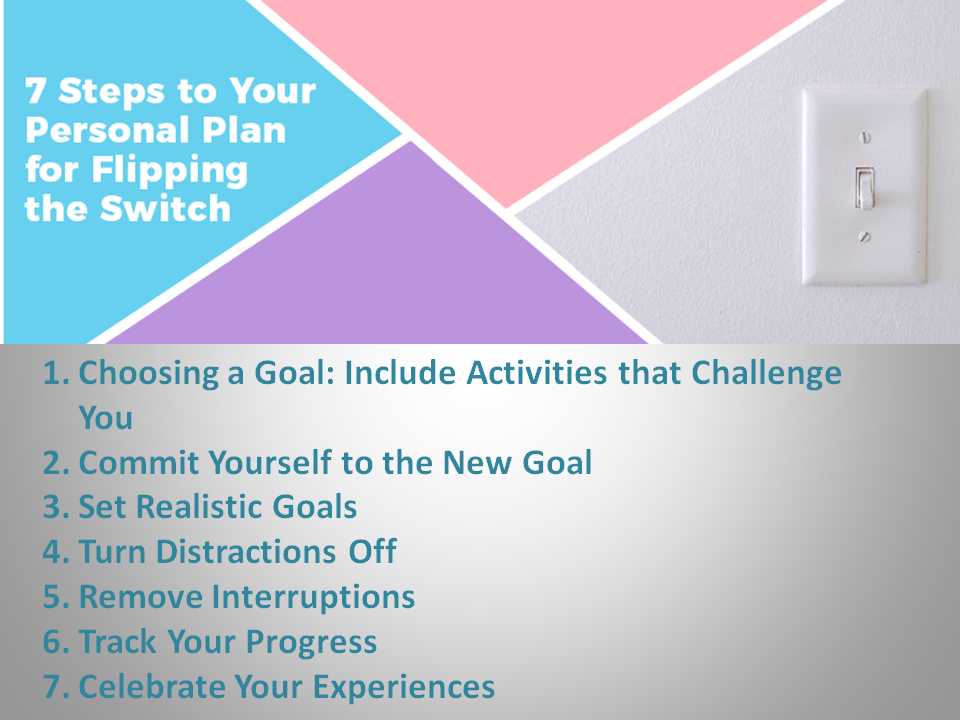
This is the third article in our series. It’s exciting to realize we are all experiencing this journey together. Although we adjust the recent changes to our personal story, we can rejoice in knowing we are the ones changing the world today for the better.
Change can seem like a massive undertaking. One that there are a million different ways to achieve if all the articles on the internet have anything to say about it. However, flipping your switch is a personal undertaking, one that may not have similar milestones for everyone. Adjust it to your needs to be successful.
Keep reading for the 7 steps you need to personalize and flip your switch.
Choosing a Goal: Include Activities that Challenge You
The activity that will most help you flip your switch is the one that challenges you, not your neighbor or your sibling. This could be as simple as folding an entire basket of laundry at one time or doing the Sunday morning crossword with an ink pen!
- My aunt tried skydiving in her 80s.
- A group of us did a pub crawl in England.
- People as old as 95 have safely bungee jumped.
- Learn how to play Pickle Ball … everyone’s doing it.
- Attempt to break a Guinness World Record.
- Become an entrepreneur.
- Try a spa getaway or an adult summer camp.
- Try a seasonal getaway.
- Remodel your home.
- Start a consulting business.
- Get into shape.
- Attend your class reunion.
- Keep up with technology and take a class on the newest gadgets.
- Try public speaking.
This is a very limited list of potential goals. Use your imagination and go big. You’ll never regret your decision to reach for the stars!
Commit Yourself to the New Goal
Whatever challenge you’re undertaking, you’re doing it for yourself. Make a promise that you will try your hardest to achieve your goal and not give up when the going gets tough.
We define commitment as a dedication or obligation that binds an individual to a particular person, cause, or course of action. We can make them willingly or unwillingly. The fear of commitment can and will affect your life in a variety of ways. Whether you try to avoid a long-term project at work or attempt to convince your child of the commitment to pursue continuing education, the challenges to commitment surround all of us.
Be willing to give of yourself to set and complete new goals.
Set Realistic Goals
Make sure your goals are attainable. You aren’t going to fold all the laundry that you do on Sunday by the end of Sunday. But maybe you could at least hang up the stuff that will wrinkle. Or perhaps you will only use a pen on the crossword answers you feel 100% certain about, pencil on the rest.
Today we need to focus our efforts, clarify our ideas, and organize our resources productively to increase our chances for success.
Professor Robert S. Rubin of Saint Louis University provided us with a good foundation when he described how we should set SMART goals. Each new goal should be:
- Specific (sensible, simple, significant)
- Measurable (meaningful, motivating)
- Achievable (agreed, attainable)
- Relevant (reasonable, results-based, realistic, resourced)
- Time-bound (time-based, time-limited, time/cost limited, time-sensitive)
Don’t forget to review your results and evaluate whether any changes to the original goal would have made attainment easier.
Turn Distractions (the T.V. or the internet) Off
Part of me wants to laugh and the other part of me wants to cry over this one. My father and my first husband attached themselves to the television set each evening like a huge dollop of superglue. Woe to anyone or anything that interrupted their viewing pleasure. Looking back on the hours my mother and I sat silently in their shadows, I mourn all the lost opportunities to connect with each other. Today, it’s even worse with everyone bending over to monitor their phones.
Get rid of the useless distractions. That show will not help you concentrate or make time go faster, so just don’t watch it. You can’t flip your switch on one activity if your brain is partially paying attention to another. We have all reached some level of screen overload since Covid hit.
According to data in Common Sense Media’s 2019 “The Common Sense Census: Media Use by Tweens and Teens,” the average teen spends 7 hours, 22 minutes on screens daily—not including for school or homework.
Media Use by Tweens and Teens 2019: Infographic. Common Sense Media. Published October 28, 2019.
Drawbacks to Constantly Being Plugged In
Studies have shown that people addicted to television and/or screen time exhibit more signs of depression. They become overly anxious and withdraw from others. They use television and screen time to divert their attention from daily fears and boredom. I actually feel sorry for those who constantly check their phones. I have a smartphone and marvel at being able to hold a computer in my hand. I’ve tried to remember to take it with me as I clean our three-story home. The problem is, I’m constantly putting the silly thing down and forgetting it. So far, I haven’t disappeared in a poof of smoke because I don’t respond immediately to every “ping.” Don’t even get me started on video games!
Remove Interruptions
Remove the kids, phones, puppy, whatever from your immediate environment. Do your best to remove the interruptions that you know will crop up and interfere with achieving your goal.
Although my job before retirement was in sales, I worked from home when not on appointments with my customers and prospects. From a time-management standpoint, I hated the monthly sales meetings at the office. Please don’t misunderstand my dilemma. I loved the people I worked with and enjoyed seeing them. The problem was I couldn’t get anything done from my desk at the office. There were constant distractions I couldn’t get away from without resorting to an impolite attitude.
Try these tips:
- Close any programs you’re not currently working on
- Schedule the time you wish to allot to each project
- Switch off working from home and from the office
- Go to work earlier and leave earlier
- Set your alarm and get up one hour earlier each day to devote that time to your new goal
- Turn off your phone
- Learn to be more assertive
- Put up a “Do Not Disturb” Sign
- Keep a list
- Do the most important tasks first
Tracking Your Progress
Find a simple way (not time-consuming, expensive, or labor-intensive) to track your progress in achieving your goal. Sometimes this is a calendar to check off days. For others, maybe you need to journal about your feelings, how well your goal-achieving event went, or the next goal you wish to achieve.
Save time by learning to use the dictation feature on your phone to dictate texts and e-mails. Tap the microphone on your phone’s keyboard to begin. Just be sure to enunciate correctly or the message may not be exactly what you’d hoped. Send yourself a text reminder of the completion of each step.
Be sure to give yourself a day off now and then to play and enjoy life.
Celebrate Your Experiences
Enjoy what you’re doing and the experiences you are having. It’s not about the destination, it’s always about the journey.
Learning to flip your switch and achieve new goals is a process, not a one-day training online. It will take time and practice to find out exactly what it takes for you to be in the zone.

This is the third article in this series. If you missed the first two, you can review them below:
6 Tips to Find Joy and Change Your Future
7 Immediate Benefits to Change